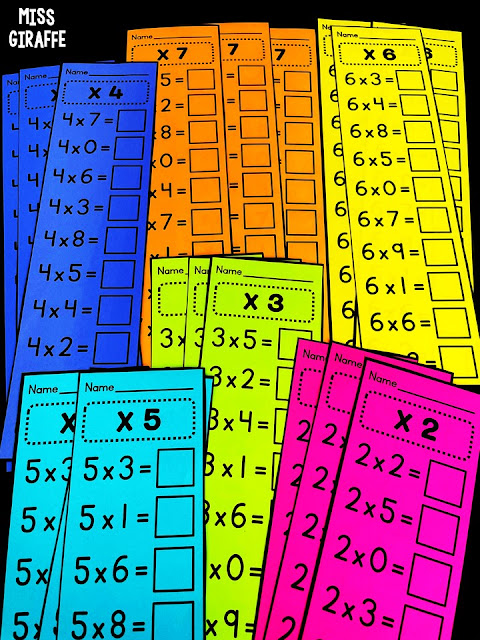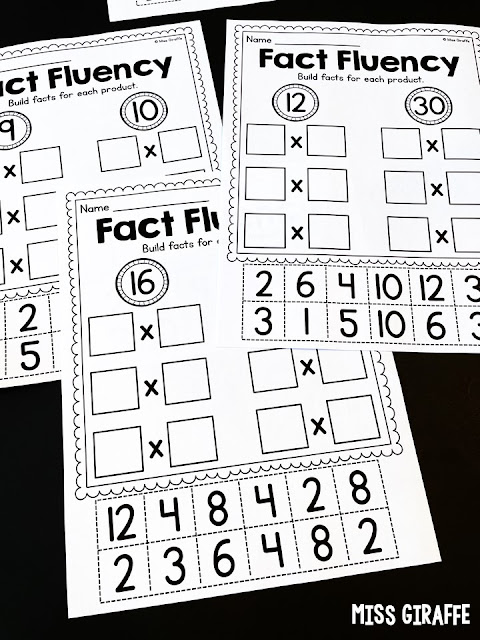Multiplication facts practice is an activity that can be SO fun if you have engaging math games and worksheets to use! I am excited to show you some of my favorite ways to help kids master their facts. Building fluency and automaticity is really important and it can be made easy with a few secrets.
Want to know how to teach multiplication facts? Here are my top 5 tips!
1. Make it super fun, of course!
You can do mazes. Puzzles! I love puzzles for math!
Number searches! Cutting and pasting activities!
You can use these activities with any age. Even "big kids" will be so excited to get to use scissors and glue during math lessons!
There are SO many ways to practice. I'll show a couple of my favorites while I share my tips.
2. Master ONE number's multiplication facts at a time.
Repetition is what will help students memorize their multiplication facts fast. And it doesn't have to be boring!
Use activities that have students seeing the same multiplication problems over and over.
Rollin' Facts is a multiplication dice game that is one of my FAVORITE ways to do this!
Each page is its own multiplication dice game that focuses on ONE number's multiplication facts at a time. They will roll dice to practice multiplying by ONLY that number (0, 1, 2, 3, 4, 5.... all the way to 12) by whatever number they roll.
This is such a fun way to get them practicing 0 facts, 1 facts, 3 facts, and so on for each number without it seeming repetitive. Especially if they play it as a game!
They can do this independently but I think it's way more fun with a partner!
If you're a parent teaching your child at home, you can play it with them and be their partner. Having it be a game you play together is a wonderful way for them to view multiplication facts practice as fun and something you're learning and doing together. :)
To play with a partner: Each student would get a sheet for the same number. Then, they each take turns rolling and filling in one equation. After each round (each partner has rolled and written their answer), they look to see who rolled the highest number and that person gets to circle their equation for that round. The person with the most circles when the sheets are filled wins! Super simple and easy game!
One of the great things about games like that is, when they play with a friend, their friend will check their answers too. They want to win so you can basically guarantee they're proofreading each other. It's a great way for them to support each other without it feeling like they're being helped.
The goal is for them to do the same problems over and over and over until they memorize them, but without them feeling like they're doing the same problems over and over and over and games like this definitely help with that! The best part is EVERY multiplication problem they roll is practicing the facts for the same number so it gives them so much repetition with the facts while feeling like a game!
3. Color code the multiplication practice tests you give to kids.
I recommend printing small strips of printable multiplication quizzes for each number. I have them in 3 sizes (3 to a page, 2 to a page, and a full page). I recommend starting with the 3 to a page size (shown here) so you can print a lot of them. Once they master that one, give them the full page test to officially master the number.
Always have the number be the same color so kids can say, "I'm working on my yellow facts" and can quickly see visually which one to grab. This makes it super easy for kids to know/remember the color they're working on.
For the record, I would call them worksheets instead of tests. Maybe quizzes. :) You want it to be fun, not stressful.
Quick Differentiation Note:
I also recommend letting them master the numbers in ANY order they choose. This helps SO much with kids potentially feeling embarrassed for feeling behind their peers.
If they can start on any number, no one knows how many numbers they've mastered and where they are.
Differentiation is SUPER important to me but I always want to try to be as discrete as possible.
Have a bunch of these strips printed out and in a place where they can grab whichever color they need to practice and do it on their own. This will help them build independence and ownership over learning their facts.
4. Make a couple "rewards" for mastering a specific number's multiplication test or quiz that are technically more practice worksheets but look fun!
Now this is a super tip. :)
Act like it's such a big deal when they master the facts for a new number because they EARNED the right to get to do a new MAZE or "Circle the" worksheet! Because they're so super smart, worked so hard, and are ready for it! Play it up like it's a big deal and they'll think it's a big deal. Because it IS a big deal. :)
I recommend handing out the "Circle the" fun worksheets at first to your students who struggle a little more, starting with smaller numbers. They all look the same except the numbers are different so, again, it's discrete.
Give the mazes to your more advanced students, slowly giving the mazes to your struggling students as they master more facts. Make sure it's not obvious you're doing this, if you can, and act like it's more of a what-happens-to-be-in-your-stack as you hand them their reward. "Great job, Martin! You get aaaaaa Circle the 12s!"
AND they'll be doing so much more additional practice with this sheet that they view as a reward. How awesome is that?! A TON of problems are packed into just one of these sheets.
5. Have a variety of activities to practice EACH number and its facts, AND each product, in many ways.
Puzzles, mazes, plain worksheets, more interactive worksheets, games, partner activities - there are so many ways to practice the multiplication facts!
I recommend a ton of variety so they get a lot of repetition with each number's facts, and each product, without it feeling like a ton of repetition.
It still probably will feel that way a little bit but this helps a lot!
Here are some of my favorite multiplication activities:
* Simple games with playing cards and dice!
Here's one example multiplication game you can play! Have kids sit with a partner with an upside down deck of cards with the face cards (king, queen, jack) taken out. They each have their own blank piece of paper.
Kids take turns drawing 2 cards, multiplying them, and writing their equation. When both kids have laid out their 2 cards, they see who made the bigger product. That person gets to circle it AND keep all 4 cards.
This will give them tons of practice multiplying numbers 1-10!
Whoever has the most cards when all the cards are used wins!
You could also say the first person to get 5 circles, 10 circles, however many you want depending on how long your math centers are.
You could also make it "endless" by not having the winner of each round keep all 4 cards and have them go in a pile to be played with again. When they run out of cards, they shuffle, put them upside down again, and keep playing and writing equation until math time is over.
Another variation:
You can also make it a little more fun by leaving in all the jacks (or all the kings, or all the queens) and saying they're a special card where, if someone draws it, they can make it be ANY number 1-10. This makes the game more exciting but also helps them see the bigger the number they make it, the more likely their product will be higher.
* Worksheets where kids cut and glue!
I love to throw in a ton of these into my math units because they're fun and great practice! Getting to physically move around the numbers really helps solidify the facts. Plus, it's basically like doing art!
These also look like a ton of fun if you print them on color paper!
* Puzzles where kids match the multiplication problems to the correct product. I LOVE puzzles for math! If you read my blog, you know I love to make puzzles for pretty much everything kids learn! :)
I recommend print them on color paper so they look super fun!
I loved puzzles as a kid so I try to bring that fun and excitement that I remember having to the math centers I create as well.
You can easily differentiate for students by which puzzles you give them. Some are easy (smaller products) and some are harder with more pieces for the larger products. I am a huge fan of differentiating.
Another way you can use these is to print them on regular copy paper and slightly scale them down with your print settings then give them to students to make a FACTS page for each number to glue onto a notebook page to make a multiplication notebook!
* Circle the ? worksheets where kids do a search to find all the hidden ways to make the product. Each worksheet focuses on 1 product.
This is one of my favorite activities because it's fun but packs in a ton of multiplication practice as they search for the multiplication facts in each worksheet puzzle.
P.S.
If you need addition facts practice too, check out my:
which shows the ADDITION version of these activities :)
If you want ALL of the activities I showed in this blog post (and more!), you can get them here:
It is PACKED with fun multiplication fact fluency activities, including all of the ones I talked about here (except the playing cards you'll need to get separately if you want to play that game).
Each game comes with teacher directions, as well as student friendly directions you can set out to have it be more independent.
If you have any students struggling with multiplication or you're trying to teach a child at home, I highly recommend checking out my Arrays activities blog post!
Rectangular arrays are a fantastic way to introduce kids to the concept of multiplication. It's very visual so it helps students understand what multiplication actually means and is a fantastic introduction.
Those activities use cookies, cereal, painting, and games to learn multiplication arrays so it's a really fun way to learn.
I hope you have enjoyed this post! Thank you for reading! :)







































0 comments:
Post a Comment